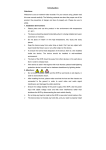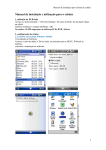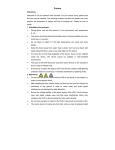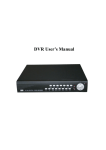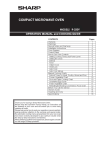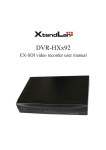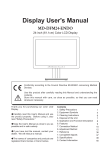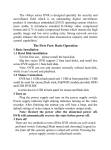Download TN-2008ΜΒ User Manual
Transcript
NVR User Manual Preface Attentions: Welcome to use our digital video recorder. For your secure using, please read this user manual carefully. The following contents are about the proper use of the product, the prevention of danger and loss of property etc. Please be sure to abide. Do not touch the power switch and the DVR by wet hands or wet objects, in order to avoid electric shock; After installing the host, please make sure that the host and the chassis are connected to the ground in order to avoid video and audio signal interference and damaged by static electricity; Ensure the voltage stability of the power supply of the DVR. Use the power input with stable voltage value and little wave interference rather than shutdown the DVR by disconnecting the main switch directly; Do not drop any liquid or metal on the DVR in case short circuit inside or fire; The device does not include any hard disk, and you need to properly install the hard disk before using it, otherwise, you cannot record and playback the video; The dust on the mainboard will cause short circuit when it is damp. In order to ensure the long-term normal working, you should regularly dedust the mainboard, connectors, chassis, fan and so on by a brush; Do not disconnect the power switch directly when you want to shutdown the DVR. You should use the shutdown button on the panel in order to avoid damage to the hard disk; Do not open the device when it is connected with electricity; To ensure the integrity of the recording data, please replace the hard disk when it is damaged (there is disk error record in the log information). Note: The user manual is for reference only. The real object is the standard; The products will be updated at any time. It is subject to update without notice. Please contact our technical department for the latest programs and additional documentation. If there is any doubt or dispute, our company reserves the right of final explanation. This user manual offer references to multi-series products. The specific -1– NVR User Manual operation of each product will not be listed one by one. Please contact our technical department when you have any question. Contents 1. Product Instruction ................................................................................ 3 2. Installation Instruction ........................................................................... 3 2.1 Open-case Inspection ................................................................. 3 2.2 HDD Installation .......................................................................... 3 .......... 3 2.3 Front Panel and Rear Panel Instruction ................................ 3. Local Operation Guide .......................................................................... 4 3.1 Start/Shutdown System ............................................................... 4 3.2 System Login............................................................................... 4 3.3 Menu Operation........................................................................... 5 3.3.1 Start Setup ...................................................................... 11 3.3.2 Display Setup.................................................................. 12 3.3.3 PTZ Setup....................................................................... 12 3.3.4 System Setting................................................................ 13 3.3.4.1 Device Parameters .............................................. 14 3.3.4.2 Channel Parameters ............................................ 14 3.3.4.3 Network Parameters ............................................ 16 3.3.4.4 Alarm&Exception .................................................. 18 3.3.4.5 Account Parameters ............................................. 19 3.3.4.6 HDD Settings ....................................................... 20 3.3.4.7 System Management ........................................... 20 3.3.4.8 Device Log ........................................................... 21 3.3.5 Playback ......................................................................... 21 3.3.6 Record Backup ............................................................... 22 3.3.7 Manual Record ............................................................... 23 3.3.8 Alarm Information ........................................................... 23 3.3.9 Snapshot ......................................................................... 24 3.3.10 File Manager ................................................................. 24 4 Network Operating Instruction ............................................................. 25 5 Mobile View Operation Guide .............................................................. 26 5.1 Client Software Obtaining.......................................................... 26 5.2 The Parameter Settings of the DVR which Supports Mobile Surveillance ......................................................................................................... 26 5.3 Android Mobile System ............................................................. 26 5.4 Blackberry Mobile System ......................................................... 28 5.5 Symbian Mobile System ............................................................ 30 5.6 Windows Mobile System ........................................................... 32 5.7 iphone Mobile System ............................................................... 33 6 Appendix .............................................................................................. 35 6.1 HDD Capacity Calculation Method for Reference ..................... 35 6.2 Remote Control Instruction .............................................................. 37 -2- NVR User Manual 6.3 Technical Data................................................................... .................42 6.4 Common Problems Resolution ................................................. 42 1. Product Instruction 1.1 Product Summary This device is a video coding and recording product specially designed for the video monitoring field, combining with H.264 video compression, large capacity HDD storage, TCP/IP network, embedded Linux operating system and other various advanced electronic information technologies, realizing high-quality image and low bit rate recording features and favourable system stability. The device meets the standard of GB 20815-2006 “Video Security Surveillance Digital Video Device” issued by the government. This device has multiple functions including recording, playback and monitoring simultaneously, realizing synchronous video and audio, with advanced control technology and powerful network data transmission ability. 1.2 Main Functions The following functional characteristics will be different due to the different series of products and their different hardware versions. Real-time Monitoring Camera Control Alarm Management and Control Compression Processing Communication Port Function Recording Function Network Function Video Playback and Backup 2. Installation Instruction 2.1 Open-case Inspection When you receive the product, please check all the things according to the DVR packing list in the box. 2.2 HDD Installation Installation Preparation: Need one cross screwdriver. This series of HDD DVR can install 2 to 8 pieces of HDD inside, and the capacity of each HDD can be up to 2TB. -3– NVR User Manual HDD Installation Steps: Twist off the screws on the side panel of the case and then open the cover of the chassis. Fix the HDD on the HDD screw whole sites of the baseboard with screws. Connect the HDD data cable and power cable. Cover the case, fix it with screws. 3. Local Operation Guide 3.1 Start/Shutdown System 3.1.1 Start System Plug power cable, press power switch, the power led will be on and the DVR will start. After booting, the video output default to multi-window output mode. If the booting time is within the record setting time period, the system will auto enable the record function. Notice: Please use the DVR matching power supply instead of any other power supply of any other type or brand. 3.1.2 Shutdown System → click Shutdown. (Note: this method is suggested when Click shutdown device in order to avoid damage to the device from electricity cut-off by accident). Notice: Before changing the HDD operation, you should shutdown the device and cut the power supply first and then operate. 3.1.3 Power Failure Recovery When the DVR is under the recording status, if the system power is cut off or the device is shut down forcefully, after reconnected with the power supply, the DVR will auto-save the video before cutting and auto-recover to the previous status and continue to work. 3.2 System Login After normal booting, single-click or press the OK key on the remote control to pop-up the login dialog box, user input the user name Admin and -4- NVR User Manual password 888888(default login password) in the input box. 3.3 Menu Operation When the user logins the system successfully, click the right mouse button: Preparation before configuration: before configure the IP channel, please make sure that the IP device has been connected with the network of the NVR and the IP device is in the same network section as the NVR. 3.3.1 Configuration of the IP Channel First method: auto search IPC 1. Click “Remote Setting” will show the below interface: -5– NVR User Manual 2. Check “Enable”, click “Search”, the IP address, protocol and port number of the IPC will appear, as shown in the below picture: -6- NVR User Manual 3. After double-click, fill in the password in the password field. 4. Click “Save”. The image will appear on the preview interface, as shown in the below picture: -7– NVR User Manual Second Method: add IPC manually. 1. Click “Remote Setting” will show the below interface: -8- NVR User Manual 2. Check “Enable”, edit the IP address and port number. Select protocol and mode. Edit user name and password. Click “Save” finally. -9– NVR User Manual 3. The image will appear on the preview interface, as shown in the below picture: - 10 - NVR User Manual press the buttons on the front panel, or press the [MENU] key on the remote control to enter the menu interface. The menu consists of start, display, PTZ, configuration, playback, backup, manual record, snapshot and document: The device enters the real-time monitoring screen after normal booting. There are superposed date, time, the channel name of every channel. Icons of record, 3D positioning and alarm status will appear in the right upper corner. 3.3.1 Start Setup Click , and the interface will display: 1) Shutdown: Click “Shutdown” button, the device will shutdown. 2) Reboot: Click “Reboot” button, the device will reboot. - 11 – NVR User Manual 3) 4) Logout: Click “Logout” button, the device will logout. Lock: Click “[ ] Lock” , the menu will be locked. 3.3.2 Display Setup Click , the interface on the right will show: Screen Type: 1) Language: Different languages for selection (For example: Simplified Chinese, Traditional Chinese and English). 2) Skin: There are original version and blue for selection. 3) Screen mode: Select different screen modes. 4) Rotation Interval: Setup the time interval of rotation. Tick “Enable SEQ” to start rotation. (Note: the rotation function can only be enabled under 1 screen) 3.3.3 PTZ Setup Click will show the below interface: 3.3.3.1 PTZ Control Before starting the PTZ control, please firstly confirm the PTZ parameter settings, PTZ protocol and the correct connection of the 485 control line etc. After setting the parameters, select the channel which you want to control in the preview interface, then control the left-handed rotation, right-handed rotation, up regulation, down regulation of the lens; zoom in and zoom out of the focal length; zoom in and zoom out of the focal point; zoom in and zoom out of the iris; setting of the PTZ speed. 3.3.3.2 PTZ Setup 1) Preset setting: first turn the camera to the needed position through the direction buttons of the PTZ control, then select a preset number, and - 12 - NVR User Manual click “Settings” button. “Preset” call: select a preset number which needs to be called, and click “Call” button. 2) Cruise setting: select a cruise number, click “Settings”, as shown in the below interface: In the cruise setup interface, select preset point, cruise time, cruise speed, click “Add” button, then the preset point of the cruise path is added successfully (multi-preset points can be added). Click “Delete” button can delete the preset point of the cruise path. “Cruise” call: select a cruise number click “Call” button. “Cruise” delete: select a cruise number , and click “Delete” button. 1) “Track” setup: select a track number, and click “Set” button, then start the PTZ control operations, and then click “Stop”, and the track is remembered successfully. 2) “Track” call: select a track number, and click “Call” button. 3.3.4 System Setting Click , and the below interface will show: - 13 – NVR User Manual 3.3.4.1 Device Parameters [Device Info] Check and modify the basic information of the device. [System Version] Check the basic information of the device system. [RS232] Can set RS232 serial port. [RS485] Can set the RS485 serial port. [DST Setting] Tick “DST” check box, then click the set button to set the start time and end time of DST. 3.3.4.2 Channel Parameters [Display Settings] The configuration parameter of every channel can be modified. 1) 2) 3) 4) 5) 6) 7) 8) Camera Name: You can modify the name of the specified channel. Time Format: You can select different time formats for the specified channel. Date Format: You can select different date format for the specified channel. Display Week: Can select different week display status for the specified channel. OSD Position: You can select any position for the OSD of the specified channel. Display Parameters: Can set the brightness, contrast, saturation and hue for the specified channel. Video Format: There are PAL and NTSC for selection. Copy To: Copy the configuration parameters to other channels. [Video Parameters] The setting parameters of every channel can be modified. 1) 2) 3) 4) 5) 6) Encoding Type: Main Stream(Normal), Sub Stream, Main Stream(Event) for selection. Stream Type: Video, Video&Audio for selection. Resolution: There are CIF, 4CIF, 2CIF etc, for selection. Bitrate Type: Constant and Variable for selection. Frame Rate: Select different value from the drop-down list, the default value is “Full Frame”. Video Quality: Select different image quality as needed, it is default to “Highest”. - 14 - NVR User Manual 7) Copy To: Copy the configuration parameters to other channels. [Schedule Record] You can set different types of record plan for each channel. 1) 2) 3) 4) 5) Enable Recording: Tick the small box before “Enable Recording” will start recording. All Day Recording: Tick the small box before “All Day Recording” to start all day recording, then you can select schedule recording, motion recording, alarm recording, command recording etc. Record Time: You can setup by 8 separate time periods. Advanced Settings: You can set the prerecord time and post record time. Copy To: Copy the configuration parameters to other channels. [Motion Detection] The parameters of each channel can be modified. 1) Area settings: Select the motion detection area, press the left mouse button and drag to the area which you want to set motion detection, click OK. 2) Alarm Schedule: Set the time intervals of alarm. 3) Linkage: Select the linkage way which you need. 4) Copy To: Copy the configuration parameters to other channels. Onvif protocol does not dupport above function [Video Lost] Can modify the parameters of each channel. 1) “Alarm Schedule”: Set the time intervals of alarm. 2) “Linkage”: Select the linkage way which you need. 3) “Copy To”: Copy the configuration parameters to other channels. Onvif protocol does not dupport above function [Video Tampering] The parameters of each channel can be modified. 1) Area settings: Select the motion detection area, press the left mouse button and drag to the area which you want to set motion detection, click OK. 2) Alarm Schedule: Set the time intervals of alarm. 3) Linkage: Select the linkage way which you need. 4) Copy To: Copy the configuration parameters to other channels. Onvif protocol does not dupport above function [Video Mask] The parameters of each channel can be modified. - 15 – NVR User Manual 1) Area settings: Select the motion detection area, press the left mouse button and drag to the area which you want to set motion detection, click OK. 2) Copy To: Copy the configuration parameters to other channels. Onvif protocol does not dupport above function 3.3.4.3 Network Parameters [Network Settings] The network basic parameters of the device can be modified. 1) 2) 3) NIC Type: there are different network card types for selections. IP: enter corresponding numbers to modify the IP address. Obtain Auto: Auto search IP function. When open DHCP, the IP/Subnet Mask/Default Gateway cannot be set; If the current DHCP is valid, then the IP/Subnet Mask/ Default Gateway will show the value obtained by DHCP; if the current DHCP is invalid, IP address etc. will show 0. 4) Device Port: Enter the corresponding device port. 5) Subnet Mask: Enter the corresponding IP subnet mask. 6) Default Gateway: Enter the corresponding gateway address. 7) MAC: Display the MAC address current network port. 8) HTTP Port: It is default to 0. 9) Multicast: Enter the corresponding multicast address. 10) Enable Wi-Fi: Tick the box before “Enable Wi-Fi” and click “Wi-Fi”, and enter the following interface: Click “Refresh”, and find the wifi router and double click. Then input the ip - 16 - NVR User Manual address, subnet mask, default gateway, DNS server address1 and DNS server address 2. 11) Enable 3G: Tick the box before “Enable 3G”, click “3G” to enter the following interface: a. The access number of the China Unicom is *99# APN address is: 3GNET. b. The access number of the China Telecom is #777 APN address is blank. c. The access number of the China Mobile is *99***1# APN address is blank. Click OK and the WAN IP will appear in the IP address bar. 12) Advance: DNS Server Address1: The IP address of the DNS server. DNS Server Address2: The standby IP address of the DNS server. Alarm Host IP: Enter the IP address of the alarm host. Alarm Host Port: Enter the port of the alarm host. Enable PPPOE: you can enable the PPPOE service: input the PPPOE user name. input the dynamic address of the device. confirm password. [DDNS Settings] Through the DDNS server, there should be a PC with fixed IP address on the internet and run this DDNS server on this PC. - 17 – NVR User Manual 1) 2) 3) 4) 5) 6) 7) Select DDNS server type(There are Ip Server, Dyndns, Peanuthull for selection). Input the server name. Input the port. Input the user name. Input the password. Confirm the password. Input the standby domain name. [NTP Settings] Enable NTP timing. 1) 2) 3) 4) 5) Server Address: Input the IP of the NTP server. NTP Port: This SNTP only supports TCP transmission. It is default to 123. Synchronize every: Input the time interval needed to be adjusted. Select Time Zone: Select the time zone of different places. GMT: You can do fine adjustment of time. [Email Settings] Setup E-mail. 1) 2) 3) 4) 5) 6) 7) Email Address: Input the email address. Password: Input the email password. Pwd Confirm: Confirm the password. Receiver: Input the email address and user name of the receiver. Interval : Select the interval of sending email. SMTP Server: Input the SMTP server address. Port: Input the SMTP server port. 3.3.4.4 Alarm&Exception [Alarm Input] Setup alarm input. 1) 2) 3) Alarm Schedule: Set the time intervals of alarm. Llinkage: Select the way of linkage. PTZ linkage: select the channel number and the action for linkage (preset, patrol, pattern) to the specified point and click ok. Copy: Copy the configuration to the other channels. [Alarm Output ] Setup alarm output. 1) 2) Alarm Schedule: Set the time intervals of alarm. Llinkage: Select the way of linkage. [Exception] Setup abnormality. - 18 - NVR User Manual 1) 2) 3) 4) 5) 6) 7) HDD Full: When there is no space in the HDD, it can trigger corresponding linkage type. Disk Fault: When there is HDD read and write fault alarm, it can trigger corresponding linkage type. Network Broken: When there is network broken alarm, it can trigger corresponding linkage type. IP Address Conflict: When there is network IP conflict alarm, it can trigger corresponding linkage type. Illegal Access: When there is illegal access alarm, it can trigger corresponding linkage type. Video Output Standard Mismatch: When the input and output format do not match the setting format, it can trigger corresponding linkage type. Video Signal Exception: When there is video signal abnormality, it can trigger corresponding linkage type. 3.3.4.5 Account Parameters [Account Setting] You can add user, modify user, set user authority, delete user. 1) 2) 3) Add User: You can set user name, password ,confirm password, user type and bind the IP address. Modify User: You can modify the user name, password, confirm password, user type and bind the IP address. User Privilege: You can setup the privilege of the new added user. - 19 – NVR User Manual 4) Delete User: Delete the new added user. [User Online]: View the user connected with the DVR, logging way, logging time and IP address. 3.3.4.6 HDD Settings You can format the HDD and view the HDD capacity, the free space and status etc. 3.3.4.7 System Management [Update] Insert the USB storage device into the DVR, click “Browse” to find the upgrade file, and click “Upgrade”. [Auto Reboot] You can select every day, every week, once and disable to maintain the system. [Stream Info.] You can view the main stream and sub stream of each channel. - 20 - NVR User Manual 3.3.4.8 Device Log You can search the logs according to different types and different date and time, as shown in the above picture. 1. Main Type of Log: There are All Type, Alarm, Exception and Operation for selection. 2. Sub Type: According to different main types, there are corresponding sub types for selection. 3. From: You can select the start time of a log you want to search. 4. To: You can select the end time of a log you want to search. 5. Export: You can export the log you have searched. 3.3.5 Playback Click , and will show the below interface: - 21 – NVR User Manual [Search]: Select and tick the channel which you want to search the recording, and it will auto search the recording which meet the search condition as shown in the below picture. 1) 2) 3) 4) 5) Stop: Stop the playing video. Slow: Slow down the playback speed. (there are:1/2, 1/4, 1/8, 1/16 times) Fast: Accelerate playback. (there are: 2, 4, 8, 16 times) Snapshot: You can snapshot in any playback channel. Backup: You can backup the recording of any channel. Insert USB storage device, click Refresh to detect the USB device. If the USB device is recognized normally, it will be displayed in the list, then select the channel, start time and end time, click “Start”, and the system will auto start backup and show the progress. 3.3.6 Record Backup Click - 22 - , and below interface will show: NVR User Manual Insert USB storage device, click Refresh to detect the USB device. If the USB device is recognized normally, it will be displayed in the list, then select the channel, start time and end time, click “Start”, and the system will auto start backup and show the progress. 3.3.7 Manual Record Click , and the interface on the right will show: Manual: the priority is the highest. No matter which status each channel is under, after carrying out "Manual" button, all the corresponding channels will start regular recording. 3.3.8 Alarm Information Click , and the interface on the right will show: All the alarm information of the device is recorded in the “Alarm” list. - 23 – NVR User Manual 3.3.9 Snapshot Single-click on the preview channel, click “Snapshot”, you can snapshot on any preview channel. 3.3.10 File Manager Click , and the below interface will show: The backup files in the external storage device and the snapshot pictures will be displayed in the document list bar. - 24 - NVR User Manual 4 Network Operating Instruction 4.1 WEB Browser Operating Instruction 4.1.1 Network Connection Confirm the DVR correct access to the network. Set the IP address, subnet mask and gateway for the computer server and DVR. Please allocate IP address in the same network segment if there is no router device in the network. If there is router device, you just need to set corresponding gateway and subnet mask. For the network setting, please refer to [Settings]>[Network Parameters]. Please make sure that the IP address setting is correct. When the IP address setting is complete, you can use the system own ping tool to check if the DVR is connected to the network correctly. 4.1.2 AtciveX Control Installation and User Login and Logout When the DVR accesses to the network correctly, you can login and visit it through IE browser You can download and install IE ActiveX from DVR through the Internet. Then input the IP address of the DVR in the IE browser, port number 5050, user name and password, then the below interface will pop-up: When Login successfully, then shows: More detail Network operation ways, please goes to the Host Side. - 25 – NVR User Manual 5 Mobile View Operation Guide This operation guide is about how to install and use the mobile softwares in the mobile phones with Android, Blackberry, windows mobile, iPhone, Symbian systems. 5.1 Client Software Obtaining You can obtain the mobile surveillance client softwares from the CD or our technical department. The corresponding client software of each system is as below: MEYE_SB_S60_3rd.sisx: mobile surveillance client of the 3rd version of Symbian S60 system; MEYE_SB_S60_5rd.sisx: mobile surveillance client of the 5th version of Symbian S60 system; MEYE_WM.cab: mobile surveillance client of Window system; MEYE_Android.apk: mobile surveillance client of Android system; MEYE_RIM.rar: mobile surveillance client of BlackBerry system; Note: Iphone uses Vmeye downloaded from appstore. 5.2 The Parameter Settings of the DVR which Supports Mobile Surveillance Resolution: CIF or QCIF; Frame Rate: 5-10fps; Stream Type: Limited Stream: 64-256Kb/S Note: you can adjust the settings according to the performance and network condition. Mobile phone with higher performance and network condition will display better effect. If the network condition is not good, you can reduce the frame rate to ensure the fluency. 5.3 Android Mobile System The mobile client software supports version above 1.5 of Android system, including HTC G1, HTC Magic, HTC Hero, HTC G5 and so on. - 26 - NVR User Manual Installation and Operation Instruction 1. 2. 3. Copy the MEYE_Android.apk to the mobile or download it from Google directly. Click the program to install. Click to run the program as shown in the picture on the right: The functions of the buttons are as below: Function Button Name Function Description Play Program connects the device and start to play the video Snapshot Capture the current image (the pictures are saved in the picture directory of the mobile phone by default) Setting Set IP address of the DVR or DDNS, port, user name, password and device name. Last Group Can select the channel of last group Next Group Can select the channel of next group About About the information. Select Channel Select to play the video of any channel of the device. Coordinating with the ”Next Group”, you can switch to 8ch or 16ch. PTZ Control Control PTZ up, down, left and right. Zoom Zoom in and zoom out Focal Length Increase or decrease the focal length Iris 4. Increase or decrease the iris Use for the first time, you need to do the following settings: - 27 – NVR User Manual Address: The public IP address or DDNS of the DVR; Port: The server port of the DVR; DVR Title: The device name of the DVR, which is used to differentiate different devices; User ID: The same as the user name on IE; Password: The same as the password on IE. : Return button. 5.4 Blackberry Mobile System The mobile client software supports version above 4.6 of blackberry system. The screen resolution should be 480*360 or 480*320, including model 8900, 9000, 9700, 9630 and so on. 5.4.1 Installation and Operation Instruction 1. 1. Install the vMEye.cod and vMEye.alx packages into the Blackberry mobile through the Desktop Manager. Click “option” on the mobile desk, then click “application” to find the vMEye and then enter. Click “Edit Permission” and set “allow” for all permissions. Some of the permissions cannot be set “allow”(the option is grey and cannot be modified) and can be ignored and click save directly. 2. 2. Click vMEye icon to run the program, then enter the initialized interface through a initialized splash interface, which is shown as below picture: - 28 - NVR User Manual Name: The device name of the DVR, which is used to differentiate different devices; Address: The public IP address or DDNS of the DVR; Port: The server port of the DVR; User ID: The same as the user name on IE; Password: The same as the password on IE. Network Type: Select the network type you want to use. 3. Click Login to enter the main interface: - 29 – NVR User Manual The functions of the buttons are as below: Function Button Name Play Full Screen Snapshot Setting Next Group About Select Channel PTZ Control Zoom Focal Length Iris Function Description Program connects the device and start to play the video Full screen play Capture the current image (the pictures are saved in the picture directory of the mobile phone by default) Set IP address of the DVR or DDNS, port, user name, password and device name. Can select the channel of next group About the information Select to play the video of any channel of the device Control PTZ up, down, left and right Zoom in and zoom out Increase or decrease the focal length Increase or decrease the iris 5.5 Symbian Mobile System Mobile client supports symbian system version above 9.1 (namely symbian 3rd and 5th version mobile), including all the 3rd version like Nokia 6120c, e71,5800 with 240*320, 320*240 resolution, the 5th version with 360*640, 640*360 resolution. ☆ Installation and Operation Instruction 1. 2. Download and Install the package file(sisx) in the phone and then you will find the program icon and find the vmeye in the specified directory. Click the vmeye program icon. After - 30 - NVR User Manual running the program, the below initialized interface will appear: The functions of the buttons are as below: Function Button Name Function Description Play Program connects the device and start to play the video Snapshot Capture the current image (the pictures are saved in the picture directory of the mobile phone by default) Setting Set IP address of the DVR or DDNS, port, user name, password and device name. Next Group Can select the channel of next group Exit Exit the program Full Screen Full screen view Select Channel Select to play the video of any channel of the device. Coordinating with the ”Next Group”, you can switch to 8ch or 16ch. PTZ Control Control PTZ up, down, left and right Zoom, Focal Length, Iris Zoom in and zoom out, increase and decrease focal length and iris. The above prompting bar will prompt the function of the selected button. 3. Use for the first time or need to modify the parameters, please click Setting button to enter the parameter setting interface, which as shown in the below picture: IP: The public IP address or DDNS of the DVR; Port: The server port of the DVR; User Name: The same as the user name on IE; Password: The same as the password on IE. Allias: Give a name to the device and it will appear on the playing page. - 31 – NVR User Manual 5.6 Windows Mobile System Mobile client supports windows system version above 2003. It only supports screen touch version currently. 1. Copy the MEYE_WM.cab to the mobile and install it. 2. Click the corresponding program icon to open as shown in the picture on the right: The functions of the buttons are as below: Function Button Name Function Description Connect and Play Program connects the device and start to play the video Setting Set IP address of the DVR or DDNS, port, user name, password and device name. Disconnect Select Channel PTZ Control Zoom Focal Length Iris Snapshot - 32 - Program disconnects the video Select to play the video of any channel of the device Control PTZ up, down, left and right Zoom in and zoom out Increase or decrease the focal length Increase or decrease the iris Capture the current image (the pictures are saved in the picture directory of the mobile phone by default) NVR User Manual 3. Use for the first time or need to modify the parameters, please click button to enter the parameter setting interface, as shown in the below picture: Username: The same as the user name on IE; Password: The same as the password on IE. Server: The public IP address or DDNS of the DVR; Port: The server port of the DVR; Notes: The description of the DVR, which is used to differentiate different devices; 4. After successful setting, press [OK] button to enter the connection interface. The image will appear if connected successfully. 5.7 iphone Mobile System Mobile client supports iphone system version iOS 3.0 or higher version, including iPhone,iPod touch and so on. Installation and Operation Instruction 1. Run the App Store of iphone, switch to search page, input vMEye in the search bar, and find the application program package, click install. After finish installation, the program icons will appear as shown in the below picture: - 33 – NVR User Manual 2. Click vMEye icon, the above initialized interface will appear. The functions of the buttons are as below: Function Button Name Play Snapshot Setting Program connects the device and start to play the video Capture the current image (the pictures are saved in the picture directory of the mobile phone by default) Set IP address of the DVR or DDNS, port, user name, password and device name. Last Group Can select the channel of last group Next Group Can select the channel of next group About Select Channel PTZ Control Zoom Focal Length - 34 - Function Description About the information Select to play the video of any channel of the device. Coordinating with the”Next Group”, you can switch to 8ch or 16ch. Control PTZ up, down, left and right Zoom in and zoom out Increase or decrease the focal length NVR User Manual Iris 3. Increase or decrease the iris Use for the first time or need to modify the parameters, please click Setting button to enter the parameter setting interface, which as shown in the below picture: Alias: The name of the DVR, which is used to differentiate different devices; Address: The public IP address or DDNS of the DVR; Port: The server port of the DVR; User ID: The same as the user name on IE; Password: The same as the password on IE. : Return button. 6 Appendix 6.1 HDD Capacity Calculation Method for Reference Install the digital video recorder for the first time, the HDD is installed inside the host. please make sure whether 6.1.1 The Capacity of the HDD The digital video recorder requires a single HDD with above 500GB capacity. In order to obtain better stability, we recommend the HDD with 500G ~ 2TB capacity. 6.1.2 The Selection of the Total Capacity Calculate the total capacity of a DVR requires according to the recording requirement ( recording type, recording file storage time ) . Calculation method: Step 1:Calculate the storage capacity qi of a channel requires per hour according to the formula(1), Unit: MByte. qi Bit Stream Size = di ÷ 8 × 3600 ÷ 1024(1) The Recording File Size in One Hour The Recording File Size in One Day - 35 – NVR User Manual 256K 112M 2.6G 320K 140M 3.3G 512K 225M 5.3G 768K 337M 7.9G 1.00M 439M 10.3G 1.50M 659M 15.4G 2.00M 878M 20.6G di - bit rate,Unit Kbit/s The following table shows the recording file size of the common bit rate under constant bit rate within one hour and one day for one channel. The second step: after confirming the time requirement of recording, calculate the storage capacity i m one channel requires according to formula(2), unit: MByte. mi = qi × hi × Di (2) hi - Di - recording time of each day(Hour) number of days of recording storage For example: the HDD capacity for recording one month for 1 channel 1.50M bit stream. Unit GB. mi = 659×24×31=490296MB= 478GB The third step: the total capacity (accumulating) qT for 16 channels timing recording for a whole day. Unit: GB q t = q16 = mi ×16 =7648GB If select 500G HDD, 16 pieces of HDD will be required to full record. User selects appropriate HDD according to the capacity. The fourth step: calculate the total capacity(accumulating) needed for allchannels alarm recording(including motion detection). Unit: GB q t ×a% a%-alarm occurring rate. Alarm occurring rate: Tn T1 + T2 + T3 +…… Tn )/n T24 (n=1,2,3…) - The alarm time of the Nth day(the time difference of larm end and alarm start) Unit: h qt - T24 - 24h the needed HDD capacity of T channels timing For example: if the alarm occurring rate a% for a month is 50%, then the alarm recording capacity of 16 channels in one month is: Unit:GB - 36 - NVR User Manual q t ×a%= q16 ×50%=7648×50%=3.7GB 6.2 Remote Control Instruction 6.2.1 4/8ch DVR Channel Remote Control Description Number Icon Description Number Icon Description 1 1-9 Number key 1-9, and 1-8 is also channel 1-8 8 ► 2 MENU Menu Key 9 ENTER 3 0/PTZ Number 0 Key/PTZ Control Key 10 ◄◄ 4 ESC Exit Key 11 QUAD Quad Key 5 ▲ Up 12 ► Play Key 6 ◄ Left 13 II Pause Key 7 ▼ Down 14 REC Record Key Right Enter Key Fast Play Key 6.2.2 16ch DVR Remote Control Description Number Icon Description Number Icon Description 1 REC Record Key 13 I◄◄ Last Section Power On/Off Key 14 ►PLAY Video Playback Window Devide Key 15 Window Devide Key 16 ▲ Up Auxiliary Function Key Device Code Key 17 ▼ Down 18 ◄ Left PTZ Control Key 19 ► Right 2 4 I► Frame Forward Frame Forward Key 5 FN 6 7 STATUS/D EV PTZ 8 II Playback Pause Key 20 9 OSD Menu Key 21 ESC Exit Key 10 ►►I Next Section 22 MENU Menu Key 11 ►► Fast Forward Key 23 1-16 Channel 1-16 12 ◄◄ Fast Backward Key Enter Key Note: When there are multiple devices in a same place, the remote control - 37 – NVR User Manual should choose a device first according to the device number. Therefore, you should define one unique device number for each machine, otherwise, the remote control operation may simultaneously affect the multiple devices which are with the same device number. 6.2.3 Remote Control Battery 1. Open the battery cover of the remote control. 2. Put into 2 pieces of No.7 batteries. Make sure that the positive and negative polarity correspond with each other rightly. 3. Close the battery cover. 6.2.4 Code Corresponding Operation of the Remote Control Press the [STATUS]/[DEV] button on the remote control, then input the DVR device number (default device number is “255”. It can be modified under Management ToolsSystem Parameter). The maximum device number which can be set is 255. Input the 3-digit device number on the remote control, adding 0 in front if the number is not up to 3-digit, then press the [ENTER] button. After completing the code corresponding operation, you can operate the DVR according to the functions on the remote control. 6.2.5 Turn on by Remote Control When the device is under the status of being selected by the remote control, keep pressing [POWER] button on the remote control can turn off the device so that it will be under standby mode. When the device is under the standby mode status of being selected, flicking on the [POWER] button can turn on the device and enter normal working condition. 6.2.6 Disable Remote Control Operation When the device is under the status of being selected by the remote control, press the [DEV] button and the remote control will terminate the control on the DVR. 6.2.7 Abnormity Check of Remote Control Check the positive and negative polarity of the batteries. Check whether the power of the batteries has run out. Check whether the remote control sensor is blocked. Check whether there is fluorescent light being used in the nearby. - 38 - NVR User Manual 6.3 Technical Data 6.3.1 1.5U 720P Economical NVR Series Technical Parameters Series 1.5U 720P Economical NVR Series Model Number Chassis 1.5U 720P 4ch NVR 1.5U 720P 9ch NVR Standard 1.5U Chassis Operating System Image Code Standard Image Code Control Dual Stream Embedded LINUX operating system H.264/MPEG4 AVC Image,code,quality,adjustable,variable,bitrate,and,constant1bitrate,optio nal Each channel can set main stream and sub stream Audio Compression G.711 Video Standard Monitoring Image Quality 720P(1280×720) 30fps/second 720p(1280×720) Recording Playback Quality Recording Playback 4ch 720P 9ch 720P Support 4ch playback simultaneously Image Motion Detection Each screen can set Region Cover Voice Talkback Every channel can set 4 cover regions Two-way voice talkback Recording Mode Recording Storage Support manual , auto, dynamic detection, alarm trigger record mode Support U disk, USB mobile HDD, USB DVD-RW, network storage and backup Local HDD Network Video Input Network Audio Input 4ch 4ch Backup Way 1.5U NVR 720P 16ch 16ch 720P detection areas and set 6-level sensitivity 9ch 9ch 16ch 16ch 9ch 1ch 16ch 4ch Video Output Audio Output 1ch VGA+1ch HDMI 1ch RCA Alarm Input Alarm Output 4ch 1ch Network Port 1 RJ45,10M/100M/1000M self-adaptive LAN port Wireless Port RS485 Port 3G, WIFI Full duplex standard 485 port USB Port 2 USB ports User name and password 3 USB ports Local Login HDD 2 SATA ports 2 SATA+1 E-SATA ports Power Supply DC12V3.5A DC12V5A Support(iPhone, Windows Mobile, BlackBerry, Symbian, Android)3G mobile phone ≤20W (without HDD) -10 oC〜+ 55 oC External Ports Mobile Surveillance Consumption Working Temperature Working Humidity Dimension Weight(without HDD) 10%-90% Equipment: 350mm×240mm×70mm, 409mm×365mm×129mm N.W.: 1.7Kg, with packing: 2.89Kg Carton Installation Way 5pcs/carton, Weight: 15.22Kg, size: 675mm×425mm×385mm Desktop installation Packing: - 39 – NVR User Manual 6.3.2 2U 720P Economical NVR Series Technical Parameters Series 2U 720P Economical NVR Series Model Number 2U 720P 9ch NVR Chassis Standard 1.5U Chassis Operating System Embedded LINUX operating system Image Code Standard H.264/MPEG4 AVC Image Code Control Image,code,quality,adjustable,variable,bitrate,and,constant1bitrate,optional Dual Stream Each channel can set main stream and sub stream Audio Compression G.711 Video Standard Monitoring Image Quality Recording Playback Quality Recording Playback Image Motion Detection Region Cover 720P(1280×720) 30fps/second Voice Talkback Two-way voice talkback Recording Mode Recording Storage Support manual , auto, dynamic detection, alarm trigger record mode Support U disk, USB mobile HDD, USB DVD-RW, network storage and backup Local HDD Network Video Input 9ch 16ch Network Audio Input Video Output Audio Output Alarm Input Alarm External Output Ports Network Port Wireless Port RS485 Port USB Port 9ch 16ch Local Login User name and password HDD Consumption 4 SATA ports 8 SATA ports+2 E-SATA ports AC110-240V ~ ATX 200W 50-60 AC110-240V ~ ATX 300W 50-60 Hz Hz Support(iPhone, Windows Mobile, BlackBerry, Symbian, Android)3G mobile phone ≤30W(without HDD) ≤40W(without HDD) Working Temperature -10oC〜+ 550C Working Humidity 10%-90% Dimension Equipment: 440mm×450mm×90mm, Packing: 539mm× 530mm×225mm Weight(without HDD) N.W.: 6.58Kg, with packing : 9.5Kg Carton 2pcs/carton, Weight: 20.45Kg, size: 555mm×545mm×470mm Installation Way Desktop installation Backup Way Power Supply Mobile Surveillance - 40 - 2U 720P 16ch NVR 720p(1280×720) 9ch 720P 16ch 720P Support 4ch playback simultaneously Each screen can set detection areas and set 6-level sensitivity Every channel can set 4 cover regions 1ch VGA+1ch HDMI 1ch RCA 9ch 16ch 1ch 4ch 1 RJ45,10M/100M/1000M self-adaptive LAN port 3G, WIFI Full duplex standard 485 port 2 USB ports 3 USB ports NVR User Manual 6.3.3 1.5U/2U 1080P Professional NVR Series Technical Parameters Series 1.5U/2U 1080P Professional NVR Series Model Number 1.5U 1080P 16ch NVR 2U 1080P 16ch NVR Chassis Standard 1.5U Chassis Standard 2U Chassis Operating System Image Code Standard Embedded LINUX operating system H.264/MPEG4 AVC Image Code Control Dual Stream Image,code,quality,adjustable,variable,bitrate,and,constant1bitrate,optional Each channel can set main stream and sub stream Audio Compression Video Standard Monitoring Image Quality Recording Playback Quality Recording Playback Image Motion Detection Region Cover G.711 1080P(1920×1080) 30fps/second Voice Talkback Two-way voice talkback Recording Mode Backup Way Support manual , auto, dynamic detection, alarm trigger record mode Support U disk, USB mobile HDD, USB DVD-RW, network storage and backup Local HDD 16ch Recording Storage Network Video Input Network Audio Input Video Output Audio Output Alarm Input External Alarm Output Ports Network Port Wireless Port RS485 Port USB Port Local Login HDD Power Supply 1080p(1920×1080) 16ch 1080P Support 4ch playback simultaneously Each screen can set mutiple detection areas and set 6-level sensitivity Every channel can set 4 cover regions 16ch 1ch VGA+1ch HDMI 1ch RCA 16ch 4ch 1 RJ45,10M/100M/1000M self-adaptive LAN port 3G, WIFI Full duplex standard 485 port 3 USB 2.0 ports User name and password Mobile Surveillance Consumption 2 SATA ports+1 E-SATA ports 8 SATA ports+2 E-SATA ports AC110-240V ~ ATX 300W 50-60 DC12V5A Hz Support(iPhone, Windows Mobile, BlackBerry, Symbian, Android)3G mobile phone ≤20W(without HDD) ≤40W(without HDD) Working Temperature -10oC〜+ 550C Working Humidity 10%-90% Dimension Equipment: 350mm×240mm×70mm, Packing: 409mm×365mm×129mm Equipment: 440mm×450mm×90mm, Packing: 539mm× 530mm×225mm Weight(without HDD) N.W.: 1.7Kg, with packing: 2.89Kg N.W.: 6.58Kg, with packing : 9.5Kg Carton 5pcs/carton, Weight: 15.22Kg, size: 675mm×425mm×385mm 2pcs/carton, Weight: 20.45Kg, size: 555mm×545mm×470mm Installation Way Desktop installation - 41 – NVR User Manual 6.4 Common Problems Resolution The device cannot start normally or keeps restarting. Possible causes: 1. DVR is upgraded with wrong program which has caused the damage to the system software. 2. The main board is defective, please contact the supplier for maintenance. 3. HDD is defective, please change the HDD. Cannot use the remote control. Possible causes: 1. Check if the batteries in the remote control are installed correctly, especially the positive and negative polarity. 2. Check if the batteries in the remote control have power. 3. Check if the remote control window is covered. 4. Please check if the remote address of the DVR matches the address of the remote control. PTZ cannot control Possible causes: 1. Incorrect cable connection of the RS-485 port, A, B ports are connected oppositely. 2. Incorrect settings of PTZ decoder type, protocol, baud rate and address bit. 3. The quantity of the PTZ connected to the RS-485 bus is relatively big, which causes the signal reflection, and you need to parallel connect a 120Ω electrical resistance in the far-end. 4. The RS-485 port of the main board is defective. The preview image of the DVR is scratched. Possible causes: Video input format is not matched. If the camera is with NTSC format but the DVR is with PAL format ,the preview image will be scratched. DVR playback image is scratched or not able to search the recording. - 42 - NVR User Manual Possible causes: 1. Program error, please try to reboot the DVR. 2. HDD data error caused by bad track and bad clusters, please detect the HDD. If the HDD is defective, please change the HDD. 3. Hardware error of DVR, please contact the supplier. DVR cannot connect network. Possible causes: 1. Please check if the network physical connection is correct or not. 2. Please check the DVR network parameter configuration. 3. Please check if IP conflict exists in the network. The download or backup video cannot play normally. Possible causes: 1. Player is not installed correctly. 2. The file system error of the backup U disk or removable hard disk. 3. Graphics speed up software whose version is above DX8.1 is not installed. - 43 –












































